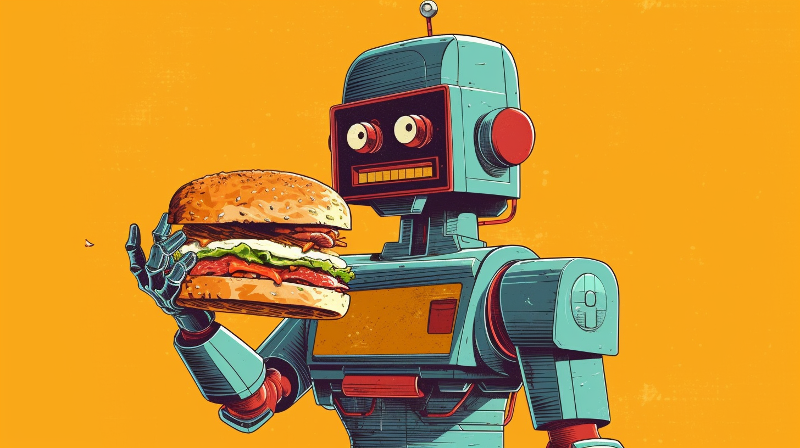
The year was a transitional one in restaurant technology. Operators of all stripes declared that more technology would be part of their futures. But the systems and capabilities that snagged their attention were often not the shiny objects of the past.
Artificial intelligence moved from the stuff of science fiction to a near obsession for tech-minded dreamers. Yet its inroads into the restaurant business were minimal, suggesting the sizzle is still far greater than the substance, at least for right now.
But those weren’t the only currents evident in the field of restaurant tech. Here are our picks of the major trends of 2023.
Artificial intelligence isn’t so smart—at least not yet
The benefits of artificial intelligence were felt minimally at best by restaurants in 2023, but all the impassioned talk about its potential may well have contributed significantly to global warming. The rollout of ChatGPT in late 2022, a true quantum leap for the emerging tech, set the industry ablaze early this year with speculation about the possibilities. Could it respond to customer complaints without human intervention? Might the computing power be harnessed to craft menus, or draft the ideal marketing plan, factoring in proven science? Or should it be used like a high-tech Eight Ball, using reams of analyzed data to affirm or blast a CEO’s decision?
Yet by the holidays, the technology was still a rarity in the business, used primarily as an improved voice-recognition tool. It was hailed by some of those early adapters, but others were ready to dismiss it as an advance as over-hyped as NFTs or bitcoin. Instead of bracing for a revolution, the industry settled into wait-and-see mode.
Ghost kitchens and virtual restaurants get shooed away
The pandemic taught restaurants that a brick-and-mortar place to eat or pick up a to-go meal were as unnecessary in the Digital Age as weaving your own tablecloths. Just brainstorm a new restaurant brand, complete with menu and logo, and pretend via your marketing that it’s real enough to throw a shadow. Then do the actual cooking in someone else’s kitchen. Who’ll be the wiser? And would customers care even if they did know?
The hitch was the public’s unexpectedly strong desire to dine out again once pandemic restrictions lifted for good. They wanted to sit at a table with other people around them, soaking up the ambience and experience. Pretend restaurants and delivery-only kitchens couldn’t meet those yearnings, and the ghost kitchens within conventional restaurants had trouble just supplying their host brands.
The exceptions proved to be old-line family-dining chains, like IHOP and Denny’s. They actually increased the number of virtual brands they offer.
A tech bubble bursts
The advances in what technology could do for restaurants turned the industry’s vendors into hot investment vehicles. Hundreds of millions were pumped into the companies with the expectation that exponential growth would continue indefinitely. No wonder newcomers sprang up like dandelions in the spring, often promising to revolutionize the business.
But somewhere along the way, the demand from restaurants failed to keep pace. It wasn’t that restaurants weren’t buying new tech. They just didn’t have to keep buying it. They also realized that big-ticket advanced systems might have been overkill for their needs. Suddenly, mundane tech like POS kitchen-display and labor-scheduling systems came back into vogue.
What followed in the supplier community was a wave of consolidations, deep staff cuts and total recasts of some businesses, and the trends appear to be continuing. Kitchen United, for instance, recently shut all of its ghost-kitchen complexes and announced that it would focus on software products going forward. That’s after GrubHub laid off 400 people and Olo cut its workforce by 85.
It remains to be seen when the flux in tech will settle down.
Kiosks get a second wind
Stations where fast-food customers can order and pay for their meals without human interaction have been around since 1977, but their history has not been one of steady growth. Seeing the effects on labor, restaurants were eager to embrace them, even if the cost can run as high as $4,000 per unit. The issue was consumer acceptance. No matter how easy the machines were to use, some patrons preferred to deal with a human.
But that resistance is waning fast, one operator after another attested in 2023. Shake Shack, KFC and Taco Bell have all indicated in recent months that the devices will become a bigger part of their operations going forward. McDonald’s first started testing the machines in 2003. Now the option is ubiquitous in its restaurants. Ditto for Panera.
Like the QR code, kiosks are an old technology that’s finally hit its stride.
This story is part of Restaurant Business’ look back at 2023. Click here to read our other year-end coverage.
Members help make our journalism possible. Become a Restaurant Business member today and unlock exclusive benefits, including unlimited access to all of our content. Sign up here.